A taste of India’s mighty Brahmaputra – and plenty of cups of tea – with Fred.\ River Cruises
As Madhab Saikia invites me to inspect the surprisingly fragrant handfuls of course loose leaves and talks passionately about his life as a taster – sometimes sampling up to 500 cups a day – I am already planning to ditch my bag and mug habit, particularly when I hear the tea that goes into them is called ‘dust’ for a reason.
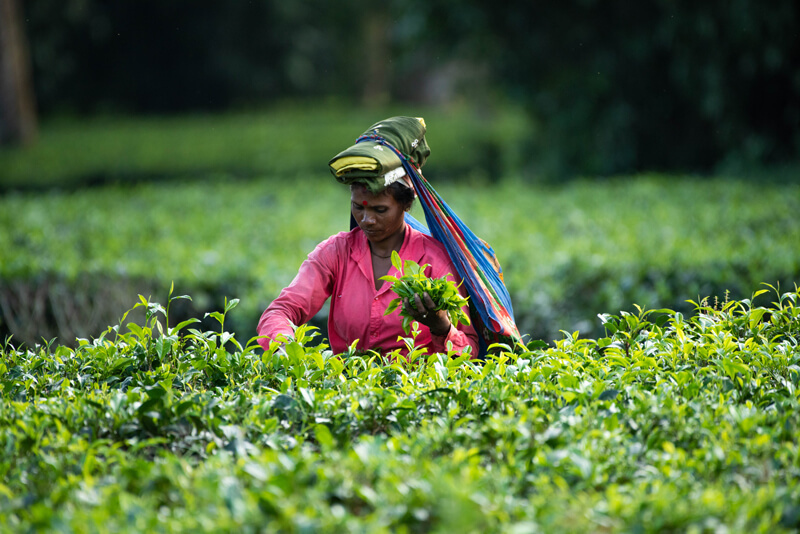 In the background women in jewel-coloured saris bend over bushes in the afternoon sunshine. They painstakingly pick just two leaves and a bud at a time and drop them into bags suspended from their heads. Meanwhile, Madhab tells us about the prized ‘second flush’, the late spring harvest that follows the first picking in March and produces superior, fuller-bodied teas.
In the background women in jewel-coloured saris bend over bushes in the afternoon sunshine. They painstakingly pick just two leaves and a bud at a time and drop them into bags suspended from their heads. Meanwhile, Madhab tells us about the prized ‘second flush’, the late spring harvest that follows the first picking in March and produces superior, fuller-bodied teas.
We’re in Assam, the world’s largest tea growing region that is a world away, as far as the tourism radar is concerned, from better-known parts of India. Whilst areas around Agra, synonymous with the Taj Mahal, are a magnet for first-time visitors, India is a vast and diverse country. The more underexposed destinations, such as the pencil slim north-eastern state of Assam, offer a remarkable variety of historical and natural attractions.
Assam still captures the whole essence of India. From the gateway city of Kolkata teeming with people, old fashioned Ambassador taxis and rickshaws to sacred cows, crumbling, palaces, ornate temples, tribal villages, lush emerald green forests and the symbol of India; the magnificent royal Bengal tiger. Apart from the last one, we saw them all.
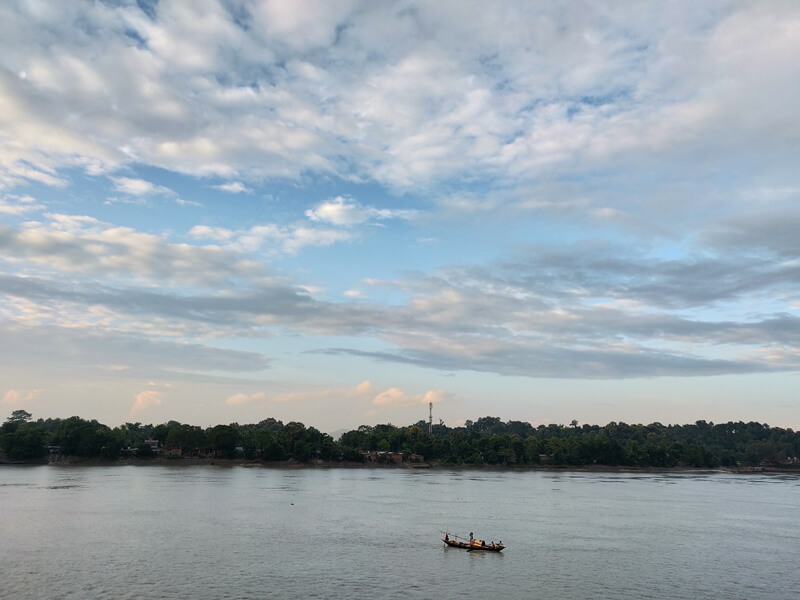 Running the length of Assam is the liquid and sacred artery of the Brahmaputra, a 2,391 waterway that rises in Tibet and flows across Assam into Bangladesh and empties into the Bay of Bengal. The world’s fastest flowing river by volume, and the only one with a view of the Himalayas in clear weather, it is a formidable force that rises up to 40ft and swells to 11 miles wide during the monsoon season. Philosophical locals living in precarious stilted houses say “what it takes away it gives back” and in the dry season they plant crops in pop up gardens on the fertile alluvial soil. The Brahmaputra is also unique as the only Indian river with a male name – son of the god Brahma, who helped created the universe – and worshipped by Hindus, Buddhists, Jains and other religions.
Running the length of Assam is the liquid and sacred artery of the Brahmaputra, a 2,391 waterway that rises in Tibet and flows across Assam into Bangladesh and empties into the Bay of Bengal. The world’s fastest flowing river by volume, and the only one with a view of the Himalayas in clear weather, it is a formidable force that rises up to 40ft and swells to 11 miles wide during the monsoon season. Philosophical locals living in precarious stilted houses say “what it takes away it gives back” and in the dry season they plant crops in pop up gardens on the fertile alluvial soil. The Brahmaputra is also unique as the only Indian river with a male name – son of the god Brahma, who helped created the universe – and worshipped by Hindus, Buddhists, Jains and other religions.
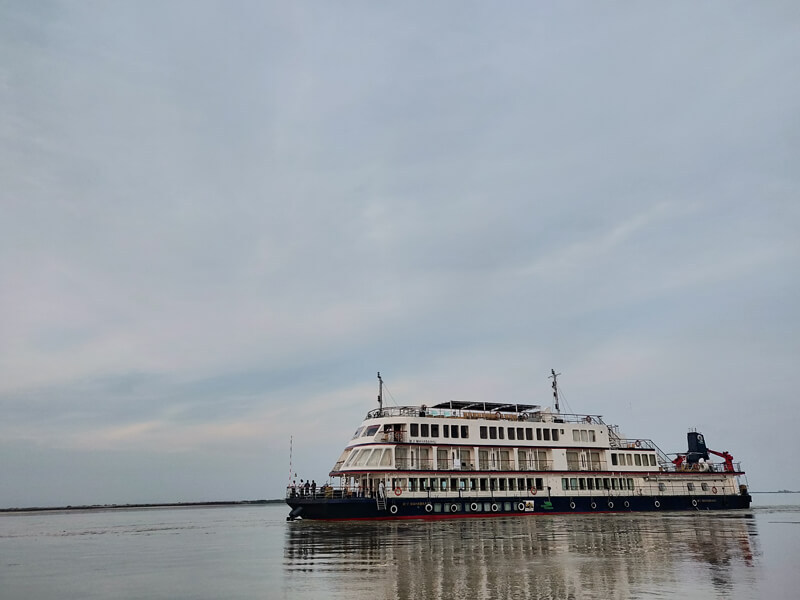 We travelled from Jorhat to Guwahati on this awe-inspiring river aboard the 46-passenger Mahabaahu, one of only a handful of vessels that tackle the Brahmaputra on sailings from October to April. Far Horizon Tours, the India-based travel specialist, operates the cosy and robust ship that’s specially equipped with three engines to sail against the upstream currents at speeds of three to seven knots. Conversely, we sometimes reached 14 knots on our downstream voyage. With channels that can change daily, the river is only navigable at day and wherever we go a pilot boat goes too – checking the water levels and hidden sand banks ahead of our progress and mooring alongside us at night. Aside from a distant sighting of another hotel boat we saw no other western tourists during our time on the Brahmaputra, making it even more of an adventure.
We travelled from Jorhat to Guwahati on this awe-inspiring river aboard the 46-passenger Mahabaahu, one of only a handful of vessels that tackle the Brahmaputra on sailings from October to April. Far Horizon Tours, the India-based travel specialist, operates the cosy and robust ship that’s specially equipped with three engines to sail against the upstream currents at speeds of three to seven knots. Conversely, we sometimes reached 14 knots on our downstream voyage. With channels that can change daily, the river is only navigable at day and wherever we go a pilot boat goes too – checking the water levels and hidden sand banks ahead of our progress and mooring alongside us at night. Aside from a distant sighting of another hotel boat we saw no other western tourists during our time on the Brahmaputra, making it even more of an adventure.
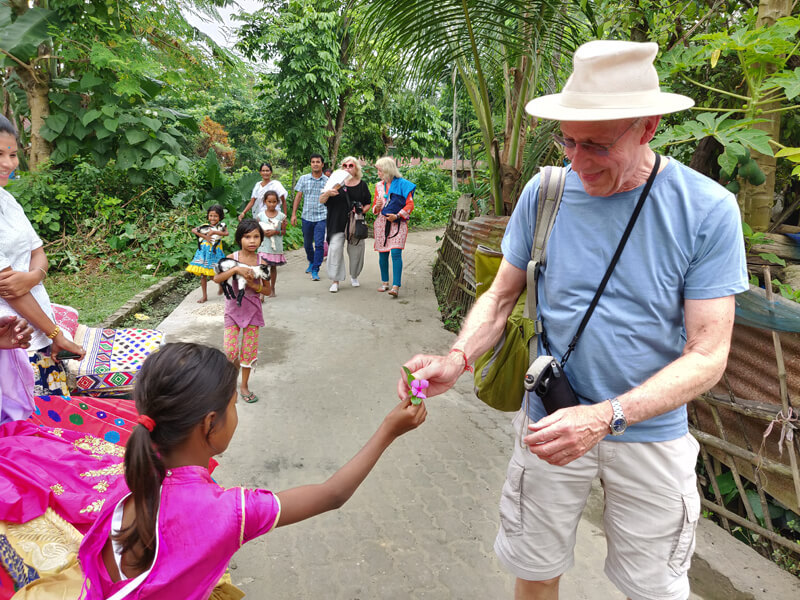 Religion is inextricably intertwined with many aspects of Indian life and the warmth and hospitality extended by people, often very poor by Western standards, is humbling. We were the subject of curious but polite interest as we toured villages, temples and historic sites. At one a group of schoolchildren nudged each other shyly until the bravest walked up, proffered a hand and announced his name. Immediately we were surrounded by all of them and they giggled as they saw their pictures on our digital cameras. Young men, with carefully coiffed hair, were eager to post for selfies too.
Religion is inextricably intertwined with many aspects of Indian life and the warmth and hospitality extended by people, often very poor by Western standards, is humbling. We were the subject of curious but polite interest as we toured villages, temples and historic sites. At one a group of schoolchildren nudged each other shyly until the bravest walked up, proffered a hand and announced his name. Immediately we were surrounded by all of them and they giggled as they saw their pictures on our digital cameras. Young men, with carefully coiffed hair, were eager to post for selfies too.
All excursions are included in the fare and each brought a kaleidoscope of sights and experiences, all interspersed with snapshots of the day-to-day lives of locals and learning about the Ahom people who were part of the ruling Assamese kingdom from 1228 to 1826. On the island of Majuli, the world’s largest river island despite being lapped by the Brahmaputra, we watched a colourful musical drama on the riverbank before sitting cross-legged in the cool of the Kamlabari temple to witness an exuberant and hypnotic dance by Vaishnavite priests variously chanting and playing cymbals and drums. Part of their worship, our guide tells us not to applaud but afterwards we could step forward to be blessed. Another very special moment.
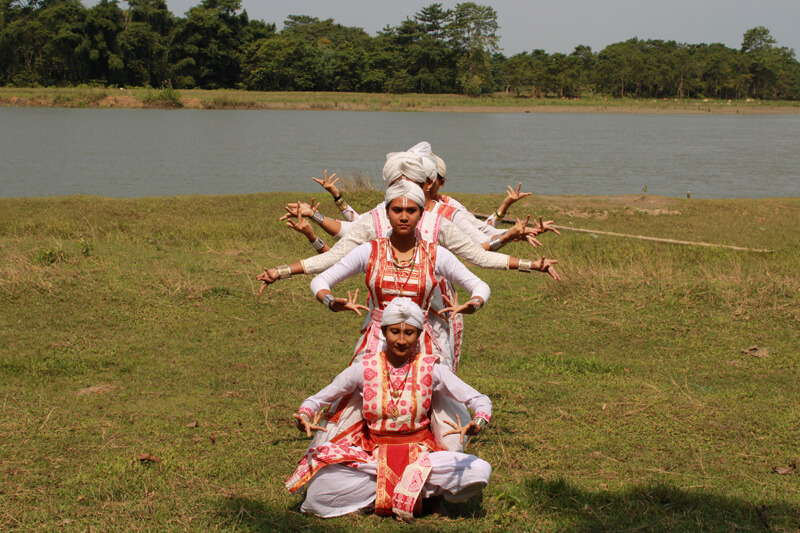 The tours are also very personal as instead of using a minibus we travel in cars, only three passengers in each and accompanied by one of the on board naturalists or other knowledgeable crew members. Indians drive on the left, well, most of the time, and one of our guides laughingly told us “road lines are just for decoration”. There’s an unwritten rule that smaller vehicles give way to their larger oncoming counterparts at the last moment and with our capable drivers we quickly got used to it.
The tours are also very personal as instead of using a minibus we travel in cars, only three passengers in each and accompanied by one of the on board naturalists or other knowledgeable crew members. Indians drive on the left, well, most of the time, and one of our guides laughingly told us “road lines are just for decoration”. There’s an unwritten rule that smaller vehicles give way to their larger oncoming counterparts at the last moment and with our capable drivers we quickly got used to it.
The seemingly organised chaos of roads was offset by many tranquil and reflective moments. One night the crew lit a bonfire on the sandbar and in the semi-darkness, overlooked by the creamy swathe of the Milky Way in the clear night sky, we floated out candles on tiny bamboo rafts, making a wish as we did so. Our cruise director Neena led morning yoga sessions, suitable for first-timers and experienced alike, all enhanced by her insight into the discipline which to Indians is far more than an exercise but a holistic and far-reaching way of life.
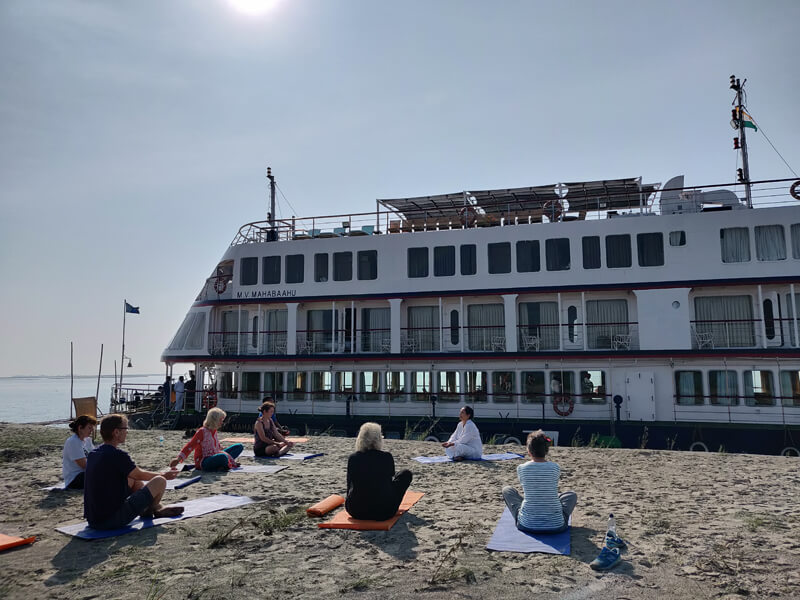 On other days we set off on small boat safaris, our sharp-eyed naturalists spotting birds, many of them unique to India such as the grey-headed fish eagle with its distinctive cream ‘pantaloons’ and barred owl, along with water buffalo, a Bengal monitor lizard and numerous other species. The wildlife highlight was a jeep safari in Kaziranga National Park, home to the largest population of the greater one-horned Rhinoceros, over 550 species of birds and, most elusively, more than 100 tigers who also prowl on the banks of the Brahmaputra.
On other days we set off on small boat safaris, our sharp-eyed naturalists spotting birds, many of them unique to India such as the grey-headed fish eagle with its distinctive cream ‘pantaloons’ and barred owl, along with water buffalo, a Bengal monitor lizard and numerous other species. The wildlife highlight was a jeep safari in Kaziranga National Park, home to the largest population of the greater one-horned Rhinoceros, over 550 species of birds and, most elusively, more than 100 tigers who also prowl on the banks of the Brahmaputra.
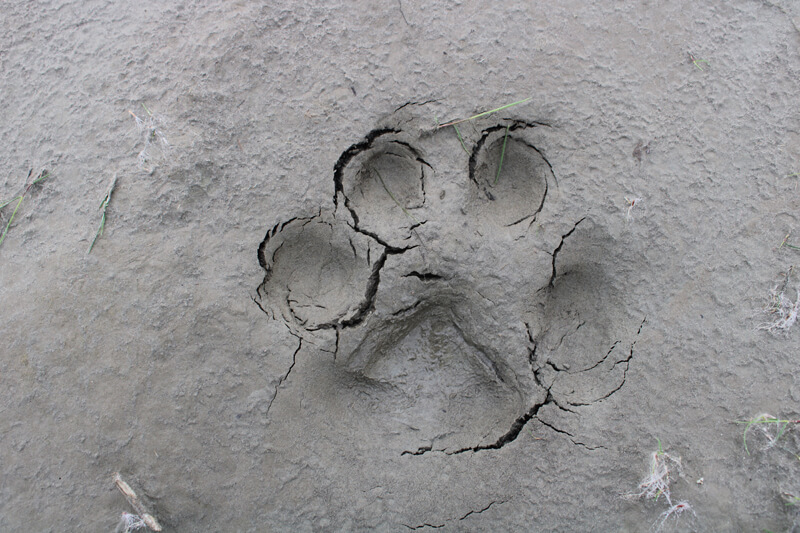 And even though a tiger metaphorically never came to tea, the sight of fresh paw prints on the river bank one afternoon reminded us of how privileged we were to be sharing their habitat with them. It provided yet another talking point which started over another cup of tea when we were back on board the Mahabaahu and extended into sunset G&T’s in the bar.
And even though a tiger metaphorically never came to tea, the sight of fresh paw prints on the river bank one afternoon reminded us of how privileged we were to be sharing their habitat with them. It provided yet another talking point which started over another cup of tea when we were back on board the Mahabaahu and extended into sunset G&T’s in the bar.
More information
Fred.\ River Cruises offers the nine-night Kolkata & the Mighty Brahmaputra River itinerary with a two-night pre-cruise stay in Kolkata and seven nights aboard the Mahabaahu including all on board meals, excursions, international and internal flights and transfers.
Photos by Mayuresh Hendre











